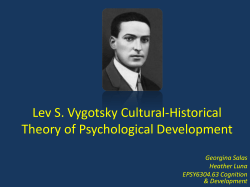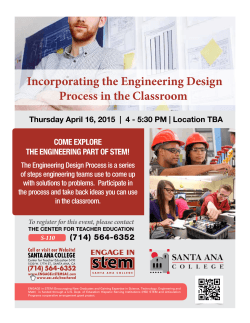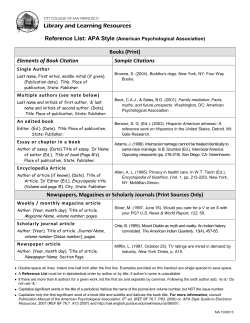
In many states, including New York, jobs in the STEMâScience
3 Columbia Place Floor 2 Albany, NY 12207 518.465.5462 518.465.5476 Brief rts I n many states, including New York, jobs in the STEM—Science, Technology, Engineering and Math—fields are growing rapidly.1 There has also been an increased focus on STEM education. Education in the arts, on the other hand, is often the first victim when the focus turns to STEM or when budgets need to be cut.2 There is evidence, however, that incorporating the arts in education can benefit students and the economy: • Most studies of the impact of the arts on student outcomes have not used experimental designs. But one experimental study found that students randomly assigned to classrooms where teachers integrated theatre arts into the language arts and social studies curricula out-performed their peers who received traditional instruction.3 Non-experimental studies have shown an association between arts education and student achievement, motivation and engagement, as well as social competence; further research is needed to determine if arts education causes these positive outcomes.4 • The arts also benefit the national, state and local One of these two tech-pioneers reported that calligraphy was among economies. For example, his most important classes and, ”It’s in in the greater Syracuse area Apple’s DNA that technology alone is in 2010, the arts industry not enough—it’s technology married generated $133 million of with liberal arts, married with the economic activity--$34 humanities, that yields us the result million by nonprofit arts that makes our heart sing.” and culture organizations, and $99 million in eventrelated expenditures by audiences. This activity supported 5,117 full-time jobs and generated $110 million in resident household income. The arts industry also generated $20 million in revenue to local and state governments. In Westchester County, the arts industry generated $156 million of economic activity--$97 million by nonprofit arts and culture organizations, and $59 million in event-related expenditures by audiences. The arts supported 4,800 full-time jobs, generated $115 million in resident household income and $23 million in revenue to local and state governments.5 • Looking at job growth between 2010 and 2020, “arts, entertainment and recreation” sector jobs are projected to grow by of 18 percent, the 6th highest level of job growth in New York (out of 20 industries).6 • Non-traditional arts industries like industrial design services, architectural and landscape architectural services and advertising also play a large role in New York’s economy and are growing faster in New York than the U.S. as a whole.7 America’s Edge is supported by tax-deductible contributions from foundations, individuals and corporations. America’s Edge accepts no funds from federal, state or local governments. More broadly, education in the arts is an integral part of our ability to compete. Yale professor Inderpal Grewal has argued: The Spiderman franchise has grossed over $3 billion worldwide, and one of the films was partially filmed in Rochester, New York, generating an estimated $600,000 for the local economy. “Movies, television, music, the art world, museums, fashion, Internet content (whatever its measure of quality), are produced by writers, musicians, artists, and designers. They do so in collaboration with technology and scientific innovation… These industries are an important part of the U.S. as a global economic power.”8 Taking an even broader view on the role of arts in the economy shows how education in the arts contributes to the competitiveness of New York companies nationally and internationally. Statewide, “independent artists, writers, and performers” generated $2 billion in 2007. But an additional $15 billion in revenue was generated by “advertising, public relations, and related services,” where training in writing and the visual and media arts is crucial for many employees.9 Steve Jobs, one of the most influential figures in the technology industry, recognized the importance of arts education: “It’s in Apple’s DNA that technology alone is not enough—it’s technology married with liberal arts, married with the humanities, that yields us the result that makes our heart sing.”10 For the competitive future of America, training in the arts and STEM education should not be an either-or proposition. It should also be noted that education in the arts is compatible with rigorous standards, including the Common Core State Standards (CCSS).11 The CCSS are goals for learning, not a curriculum or teaching methods. Teachers are free to use various methods, including integrating the arts, in teaching English language arts or other academic subjects. Preliminary research suggests this can be an effective approach to improving student achievement. And, it just might help these students in the future create the competitive edge their employers will need. Endnotes 1 America’s Edge (2013, May). Ensuring the Capital Region’s global success: Reversing our “skills gaps” through high school education models. Washington, DC: Author. Retrieved from: http://americasedge.s3.amazonaws.com/wp-content/uploads/AE-NY-Skills-Report.pdf 2 President’s Committee on the Arts and the Humanities (2011, May). Reinvesting in Arts Education: Winning America’s Future Through Creative Schools. Washington, DC: Author. Retrieved from: http://www.pcah.gov/sites/default/files/PCAH_Reinvesting_4web_0.pdf 3 Walker, E. M., McFadden, L. B., Tabone, C., & Finkelstein, M. (2011). Contribution of drama-based strategies. Youth Theatre Journal, 25(1), 3-15. 4 President’s Committee on the Arts and the Humanities (2011, May). Reinvesting in Arts Education: Winning America’s Future Through Creative Schools. Washington, DC: Author. Retrieved from: http://www.pcah.gov/sites/default/files/PCAH_Reinvesting_4web_0.pdf 5 Arts & Economic Prosperity IV. Retrieved from: http://www.artsusa.org/information_services/research/services/economic_impact/iv/local.asp 6 Carnevale, A.P., Smith, N., & Strohl, J. (2013) Recovery: Projections of jobs and educational requirements through 2020. Retrieved from: http://www9.georgetown.edu/grad/ gppi/hpi/cew/pdfs/New%20York2020.pdf 7 United States Census Bureau. 2002 and 2007 economic census: Industry snapshots. Retrieved from: http://www.census.gov/econ/census/snapshots/ 8 Grewal, I. (2011, October 12). A lesson from Steve Jobs: Arts and technology education are related. Huff Post Education. Retrieved from: http://www.huffingtonpost.com/ inderpal-grewal/steve-jobs-arts-education_b_1007221.html 9 United States Census Bureau. 2002 and 2007 economic census: Industry snapshots. Retrieved from: http://www.census.gov/econ/census/snapshots/ 10 Washwa, V. (2011, March 21). Engineering vs. liberal arts: Whose right—Bill or Steve? Retrieved from: http://techcrunch.com/2011/03/21/engineering-vs-liberal-artswho%E2%80%99s-right%E2%80%94bill-or-steve/ 11 Common Core State Standards Initiative (n.d.) Frequently asked questions. Retrieved from: http://www.corestandards.org/resources/frequently-asked-questions www.AmericasEdge.org
© Copyright 2025












